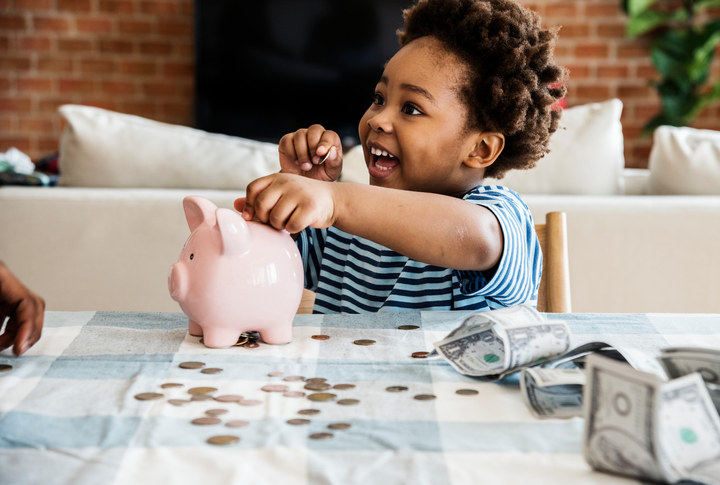I first learned how to count money around age six, when my grandfather offered a handful of coins in exchange for me doing little tasks around the house, like bringing over his beer or slippers. As a now-adult with a toddler son, I not only applaud Gramp’s smarts — I, too, appreciate sitting on the couch while my child runs mini-errands for me — but I look at my 2-year-old and wonder how to teach him good financial habits. Because a.) my own skills are limited to “Avoid store credit cards” and “Always have an emergency fund,” and b.), kids these days will probably view money as this totally abstract thing that’s always available from a screen after a few clicks.

Luckily, experts say you don’t have to be a fiscal genius in order to teach children how to spend, save, and invest — or prepare for the end of modern capitalism, IDK. (Also, if you’re feeling like, “Wow, perhaps *I* need some of these financial lessons before worrying about my kid,” we've got a few personal finance book recommendations at the end of this post to get you started.) I asked a wide range of parents and financial professionals to share their best strategies for turning money lessons into age-appropriate activities. Here’s what they said.
For toddlers (ages 2-4)

Simplify basic concepts: People use money to buy things, and coins and dollars have value. “It’s never too early to start talking to your children about money,” financial advisor Matt Gellene tells BuzzFeed. “One of the best times to teach younger children about money is when they start to notice it, which can happen as early as they turn three, four, or even two years old. Keep it as simple as possible and geared to your child’s level of understanding — talk to them about a toy, game or book they want, and how much it costs. Once they know how much it costs, you can talk to them about how long it may take them to save.”
What parents can do:
Talk about how people make money. “At this age, just having conversations with kids can help lay down important groundwork. Talk about different jobs people have and how they make money. Start talking about the difference between needs and wants: they need food, but not that toy they are begging for.” —Tony Drake, father and financial planner
Identify and count coins. “With my 3-year-old granddaughter, I started with introducing coins: a penny, then nickel, then a dime, then the quarter. Once she could recognize each coin, we started counting: a penny is 1, nickel is 5, a dime is 10 and a quarter is 25.” —Sharon Nixon-Crenshaw, a grandmother of three kids ages 3, 4 and 8

Help make a small purchase with cash. “At three, our son was asking for a Hot Wheels car every time we went to the store. Because his interest was so focused, I got out coins and explained to him their worth. Very quickly, he realized four round quarters would purchase a new set of shiny wheels. This provided many discussions about money, even at his young age. Children are very literal and factual, so teaching the value of money using real coins and cash was highly effective.” —Holly Weidman, mom and personal finance blogger
Introduce a piggy bank. “Get a piggy bank and give your child five one dollar bills for their birthday starting at age three. For every dollar they put in the bank, give them a treat, like a M&M or gummy bear. Very similar to potty training, you want your child to be excited to put money in the bank because they get a reward.” —Jennifer Beeston, mom and mortgage lending expert
Play with money. “I remember having a toy cash register when I was young, and my brother and I would try to sell our plastic groceries to my parents, friends, or whoever set foot in our house. Granted, we were accepting the fake cash, cards, and coins that came with the toy set, but it help set a foundation of what the real world was like. It was extra helpful when we went to the grocery store with Mom and Dad because we were able to see how the real transactions happened. This would lead to questions about money, the value of the groceries, and we'd take those lessons back to our play grocery store.” —Tyler Dolan, financial planner
For elementary and middle school kiddos (ages 5-12)

Talk about where money comes from, and what it can be used for. Kids should start to realize that money isn’t finite, and it can also be saved. As you reach the older end of this age range, you can start reinforcing details like coupons, cost comparison, sales tax, etc.
“With my 6-year-old, gifts make up most of his past experience with money,” explains entrepreneur Sam Eitzen, who has three kids. “Chores are a new phase, as he's old enough to be really helpful now. Work is the furthest one out, but he understands that 'work' and 'selling' can be sources of money, too. If I ask him what else can money be used for, he lists things like clothes, adventure gear and cake pops. I introduce use cases like rent, cars, gas, travel, internet — and how all these things cost money. As basic as that sounds, he never considered for a second that internet cost money.”
What parents can do:
Talk about how to save, and why saving is important. “Around age 3 or 4, I could show them that for $1 they could buy, say, a pack of gum or some Tic-Tacs. But down the road a bit I introduced saving as, ‘Well, if you save that $1 and a few more, you can get a match box car.’ I always keep it as basic as possible. Also, we live a nice life, and we often talk about how hard we worked to build that as we don’t want the boys to think it’s ‘easy’ or even ‘normal.’ We make sure our boys know it took a lot of studying, hard work, and saving to get there.” —Courtney Glantz, food blogger and mom of two

Practice setting aside money for spending, saving, and giving. “Starting around age 8, get three containers and have your child label them: spending, saving, giving. Every time your child receives money, have them put a portion into each bucket: 10% for giving, 20% for savings, 70% for spending. Have them select a cause, and every month, show them how to use their giving money to help the cause they've chosen. Open a savings account, and each month, take them with you to the bank and show them how you deposit their money into their savings account. And the next time your child wants you to buy them a nonessential item, have them use their spending money to help pay for it.” —Financial educator Tiffany Aliche of The Budgetnista
Ask them to guess what things cost. “When you go out to eat, have your kid guess the cost of the bill. This gives perspective and helps them understand the difference between fast food and a nicer restaurant. You can also discuss why the costs are different and if they think the difference in price is worth the change in quality.” —Bob Finley, financial planner

Don’t just say “We can’t afford that.” “One mistake I made was telling my kids ‘we can't afford that’ when they asked for something, even if it wasn’t quite true. For example, if your child says, 'Let's go to Disney World over spring break,' and you actually could come up with money to pay for the trip but it's not a priority, saying 'we can't afford it' is not only a cop-out — it’s also a missed opportunity to teach about trade-offs. It's much more productive to say something like, 'We're not choosing to spend our money on that' or 'If we spend money on a trip to Disney World, then we won't have the money we need for summer camp.'” —Elizabeth Odders-White, mom and associate professor of finance at Wisconsin School of Business
Give an allowance based on completing chores. “Depending on your child's age, consider giving them a standard set of household chores or tasks to complete in order to earn their allowance. Attach a dollar value to the successful completion of each task. This will help get kids thinking about the value of time and money, and create an understanding from an early age that every dollar must be earned.” —Kristin McFarland, wealth advisor
Another option: only give an allowance for bonus chores. “I remember my parents had a list of chores my brother and I could complete for different amounts of money. We always fought over the highest paying jobs, but quickly realized these chores took the most time, sweat, and energy.” —Dolan

Compare prices together. “Whenever we have to buy something, I make sure they watch me comparison shopping online. It’s harder for parents now to teach kids how to be a savvy shopper because we do so much online and with credit cards, which to kids just looks like invisible magic, but you can still have them look over your shoulder. For example, when you are comparing products on Amazon, show them how to search for the lowest price but also to check reviews other customers have left.” —Kimberly Palmer, personal finance expert at NerdWallet
Practice spending at yard sales. “A garage or yard sale is great practice for kids to conduct sales transactions, as they often have to politely ask how much things cost. It's a safe place to make mistakes, because no matter how useless a toy purchase might be, chances are they only blew a few bucks.” —Janet Alvarez, personal finance expert at Wise Bread
For teenagers (ages 13-18)

Start supporting a little financial independence, so your kid can learn what makes a good decision (and a bad one) in low-risk situations. Be open about topics like budgets, setting up bank accounts, credit cards, bills, loans, and investments. Most of all, don’t rush to bail them out when they make a mistake. “This is a good age to explain a budget and help your kids really understand the importance of having one and sticking to it,” says Drake. “Use your own household budget as an example — explain the different kinds of bills you have to pay and the consequences of not paying them. And if your kids make mistakes, let them experience the consequences. If they get their allowance on Friday, but discover something they want on Wednesday, have them wait. When their money’s gone, it’s gone.”
What parents can do:
Talk about financial mistakes you’ve made. “It's important for parents to remember that they don't need a perfect financial track record in order to be great teachers for their kids. Even poor financial choices present opportunities for learning if they are discussed openly.” —Odders-White

Start talking about debt. “Stress the importance of only borrowing what you need, and explain how debt makes a dent in your budget and can prevent you from buying the things you want or need. Credit cards are another part of the debt conversation. A credit card can help build your child’s credit, but only if you do it correctly. If your child chooses to have a credit card, help them pick one that has low fees and a low APR. Hit home the importance to pay off your credit card bill every month.” —Drake
Set boundaries: what you’ll pay for and what you expect them to pay for. “My 13-year-old is babysitting a lot and earning good money. She now covers the cost of most of her activities with her friends, such as movies, bowling, mini-golf, etc. Also, when she goes into town she pays for her snacks and meals. We still pay for activities we do as a family, and for all her extra-curricular activities, clothes and toiletries. We don’t want to push our kids to feel obligated to work an inordinate amount time that takes away from school, but I believe it’s healthy to ask our teens to cover some of their own expenses when they start earning money.” —Bisiker

If you can afford to, buy stock, and explain how investments work. “We let our oldest pick a stock. I told him to pick a company that he likes and uses in some capacity, and that he believes will stick around and continue to do a good job. He picked JetBlue. (We fly JetBlue a lot.) The stock is up about 5% since we bought it, and I show him regularly how it's doing. I also explained that it's a long game — that the stock can go up and down with the company's fortunes and investors' perceptions. But the more important lesson was in helping him understand that you can be both a customer and an investor in a company. He loved the idea that you can actually be a part owner of a company that you love. Obviously, there's more to investing in stocks than that. But the first lesson that we wanted to convey was to think of yourself as not just a consumer, but also an investor. Down the road, we'll explain other important concepts like diversification and investing in low-cost funds. But first I wanted him to be able to connect the stock market to something real and present in his life — e.g. owning some shares of JetBlue means you own a part of this company that you use to fly to see your grandparents.” —Jennifer Barrett, Chief Education Officer for Acorns and mom of two, ages 7 and 11
Submissions have been lightly edited for length and clarity.
Personal finance book recommendations for adults:
Note: this doesn’t encompass every resource out there, but is at least a short list to get going.
